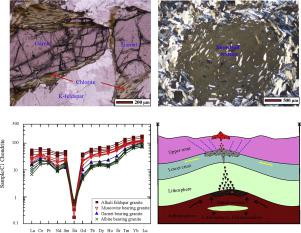Our official English website, www.x-mol.net, welcomes your
feedback! (Note: you will need to create a separate account there.)
Assessment of magmatic versus post-magmatic processes in the Mueilha rare-metal granite, Eastern Desert of Egypt, Arabian-Nubian Shield
Lithos ( IF 2.9 ) Pub Date : 2020-08-01 , DOI: 10.1016/j.lithos.2020.105542 Amany M.A. Seddik , Mahmoud H. Darwish , Mokhles K. Azer , Paul D. Asimow
Lithos ( IF 2.9 ) Pub Date : 2020-08-01 , DOI: 10.1016/j.lithos.2020.105542 Amany M.A. Seddik , Mahmoud H. Darwish , Mokhles K. Azer , Paul D. Asimow

|
Abstract The Mueilha rare-metal granite, exposed in the central Eastern Desert of Egypt, is a post-collisional intrusion that formed in the final magmatic stage of the evolution of the Arabian-Nubian Shield. The Mueilha intrusion was emplaced as a high-level magmatic cupola into metamorphic country rocks. It consists of two cogenetic intrusive bodies: an early phase emplaced at shallow depth and now penetratively altered to white albite granite and a later phase of red granites emplaced at greater depth that better preserve magmatic features. The albite granite is less common and represents the upper margin of the Mueilha intrusion, the apex of the magmatic cupola. The red granites are volumetrically dominant and appears to have crystallized from the margins inward, forming a composite pluton zoned from muscovite granite to alkali feldspar granite. All parts of the Mueilha pluton appear to have been emplaced within a short time interval, before complete crystallization of the earliest phase. The geochemistry of the Mueilha granites is typical of rare-metal granites, characterized by high SiO2, Na2O + K2O, Nb, Rb, Ta, Y, U, Th, Sn, and W with depletion in P, Mg, Ti, Sr and Ba. They are weakly peraluminous and highly fractionated with A-type character. The chondrite-normalized REE patterns have strongly negative Eu anomalies, typical of highly differentiated granites that evolved through a transitional magmatic–hydrothermal stage. The primary magma feeding the Mueilha intrusion was generated by partial melting of the juvenile crust of the Arabian-Nubian Shield; it subsequently underwent extensive fractional crystallization and metasomatism by late- to post-magmatic fluids. Separation of fluids from the oversaturated melt promoted both diffuse greisenization and focused segregation of pegmatite and fluorite and quartz veins. Alkalis liberated from feldspars consumed by greisenization were redeposited during albitization in the uppermost part of the magma chamber. Despite penetration of the intrusion boundary by discrete dikes, veins, and aphophyses, diffuse alteration of the metamorphic country rocks is not apparent. Primary columbite-series minerals crystallized from the melt and were later partly replaced by secondary Nb and Ta minerals (fluorcalciomicrolite and wodginite) during hydrothermal alteration.
中文翻译:

埃及东部沙漠、阿拉伯-努比亚地盾 Mueilha 稀有金属花岗岩中岩浆作用与后岩浆作用的评估
摘要 埃及中东部沙漠出露的Mueilha稀有金属花岗岩是阿拉伯-努比亚地盾演化的最后岩浆阶段形成的碰撞后侵入体。Mueilha 侵入体作为高级岩浆冲天炉进入变质岩中。它由两个共生侵入体组成:早期阶段位于较浅的深度,现在已穿透改变为白色钠长石花岗岩,后期阶段为红色花岗岩,位于更深的位置,可以更好地保留岩浆特征。钠长石花岗岩不太常见,代表了 Mueilha 侵入体的上缘,即岩浆冲天炉的顶点。红色花岗岩在体积上占主导地位,似乎从边缘向内结晶,形成从白云母花岗岩到碱性长石花岗岩的复合岩体。在最早阶段完全结晶之前,Mueilha 岩体的所有部分似乎都在很短的时间间隔内就位。Mueilha 花岗岩的地球化学是典型的稀有金属花岗岩,其特征是高 SiO2、Na2O + K2O、Nb、Rb、Ta、Y、U、Th、Sn 和 W,并缺乏 P、Mg、Ti、Sr 和巴。它们是弱过铝质,高度分馏,具有 A 型特征。球粒陨石归一化的 REE 模式具有强烈的负 Eu 异常,这是通过岩浆-热液过渡阶段演化的高度分化花岗岩的典型特征。为 Mueilha 侵入体提供营养的原生岩浆是由阿拉伯-努比亚地盾的幼年地壳的部分熔融产生的;随后它经历了晚期到后期岩浆流体的广泛分馏和交代作用。流体与过饱和熔体的分离促进了伟晶岩、萤石和石英脉的弥散灰化和集中分离。从灰化消耗的长石中释放出来的碱在白化过程中重新沉积在岩浆房的最上部。尽管离散的岩脉、脉和隐突侵入侵入边界,但变质围岩的弥散蚀变并不明显。原生铌铁矿系列矿物从熔体中结晶出来,后来在热液蚀变过程中被次生 Nb 和 Ta 矿物(氟钙微晶石和 wodginite)部分取代。从灰化消耗的长石中释放出来的碱在白化过程中重新沉积在岩浆房的最上部。尽管离散的岩脉、脉和隐突侵入侵入边界,但变质围岩的弥散蚀变并不明显。原生铌铁矿系列矿物从熔体中结晶出来,后来在热液蚀变过程中被次生 Nb 和 Ta 矿物(氟钙微晶石和 wodginite)部分取代。从灰化消耗的长石中释放出来的碱在白化过程中重新沉积在岩浆房的最上部。尽管离散的岩脉、脉和隐突侵入侵入边界,但变质围岩的弥散蚀变并不明显。原生铌铁矿系列矿物从熔体中结晶出来,后来在热液蚀变过程中被次生 Nb 和 Ta 矿物(氟钙微晶石和 wodginite)部分取代。
更新日期:2020-08-01
中文翻译:

埃及东部沙漠、阿拉伯-努比亚地盾 Mueilha 稀有金属花岗岩中岩浆作用与后岩浆作用的评估
摘要 埃及中东部沙漠出露的Mueilha稀有金属花岗岩是阿拉伯-努比亚地盾演化的最后岩浆阶段形成的碰撞后侵入体。Mueilha 侵入体作为高级岩浆冲天炉进入变质岩中。它由两个共生侵入体组成:早期阶段位于较浅的深度,现在已穿透改变为白色钠长石花岗岩,后期阶段为红色花岗岩,位于更深的位置,可以更好地保留岩浆特征。钠长石花岗岩不太常见,代表了 Mueilha 侵入体的上缘,即岩浆冲天炉的顶点。红色花岗岩在体积上占主导地位,似乎从边缘向内结晶,形成从白云母花岗岩到碱性长石花岗岩的复合岩体。在最早阶段完全结晶之前,Mueilha 岩体的所有部分似乎都在很短的时间间隔内就位。Mueilha 花岗岩的地球化学是典型的稀有金属花岗岩,其特征是高 SiO2、Na2O + K2O、Nb、Rb、Ta、Y、U、Th、Sn 和 W,并缺乏 P、Mg、Ti、Sr 和巴。它们是弱过铝质,高度分馏,具有 A 型特征。球粒陨石归一化的 REE 模式具有强烈的负 Eu 异常,这是通过岩浆-热液过渡阶段演化的高度分化花岗岩的典型特征。为 Mueilha 侵入体提供营养的原生岩浆是由阿拉伯-努比亚地盾的幼年地壳的部分熔融产生的;随后它经历了晚期到后期岩浆流体的广泛分馏和交代作用。流体与过饱和熔体的分离促进了伟晶岩、萤石和石英脉的弥散灰化和集中分离。从灰化消耗的长石中释放出来的碱在白化过程中重新沉积在岩浆房的最上部。尽管离散的岩脉、脉和隐突侵入侵入边界,但变质围岩的弥散蚀变并不明显。原生铌铁矿系列矿物从熔体中结晶出来,后来在热液蚀变过程中被次生 Nb 和 Ta 矿物(氟钙微晶石和 wodginite)部分取代。从灰化消耗的长石中释放出来的碱在白化过程中重新沉积在岩浆房的最上部。尽管离散的岩脉、脉和隐突侵入侵入边界,但变质围岩的弥散蚀变并不明显。原生铌铁矿系列矿物从熔体中结晶出来,后来在热液蚀变过程中被次生 Nb 和 Ta 矿物(氟钙微晶石和 wodginite)部分取代。从灰化消耗的长石中释放出来的碱在白化过程中重新沉积在岩浆房的最上部。尽管离散的岩脉、脉和隐突侵入侵入边界,但变质围岩的弥散蚀变并不明显。原生铌铁矿系列矿物从熔体中结晶出来,后来在热液蚀变过程中被次生 Nb 和 Ta 矿物(氟钙微晶石和 wodginite)部分取代。











































 京公网安备 11010802027423号
京公网安备 11010802027423号